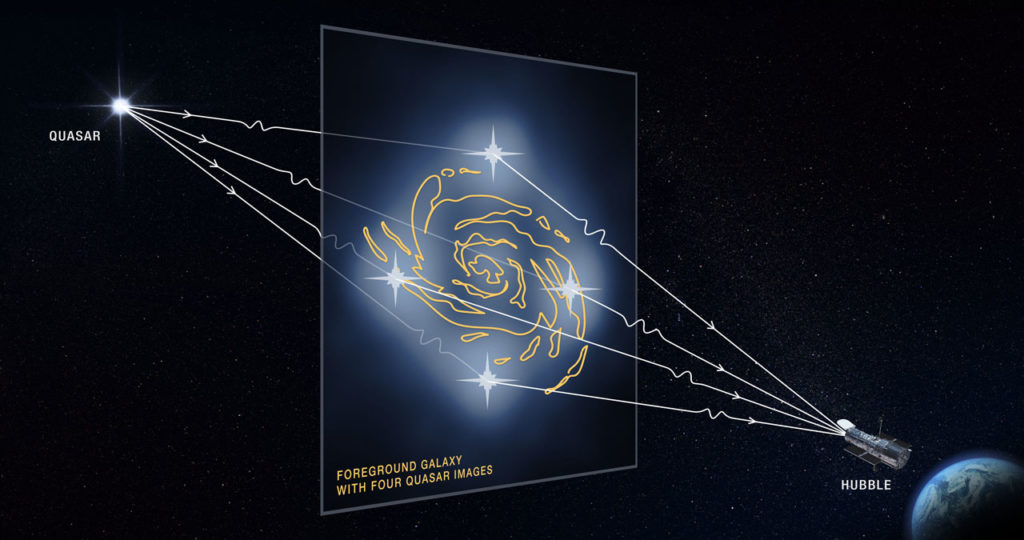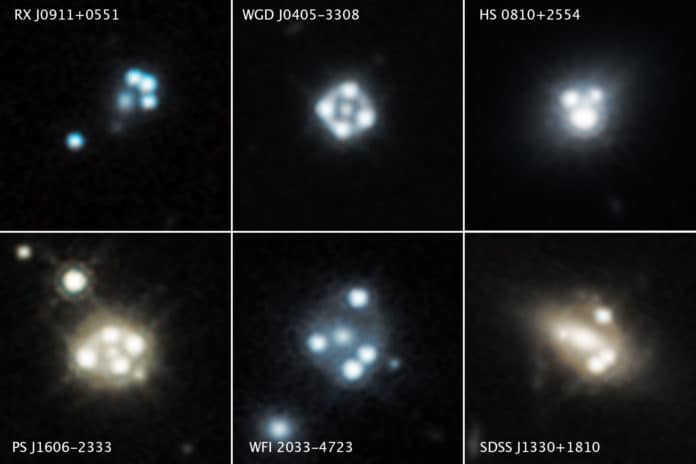Roughly 80% of the mass of the universe is made up of material that scientists cannot directly observe. Known as dark matter, this unusual ingredient does not emit light or energy.
We know that dark matter exists because of the effect it has on objects that we can observe directly. According to scientists, dark matter may account for the unexplained motions of stars within galaxies.
Recently, astronomers discovered much smaller clumps of dark matter that had not been found until now. These clumps were found around large- and medium-sized galaxies. This discovery confirms one of the fundamental predictions of the widely accepted “cold dark matter” theory.
A huge Thanks to NASA’s Hubble Space Telescope and a new observing technique that enabled scientists to observe hot dark matter forms much smaller clumps than previously known. These clumps were found around large- and medium-sized galaxies.
The cold dark matter theory suggests that all the galaxies form and are embedded within clouds of dark matter. Dark matter itself consists of slow-moving, or “cold,” particles that come together to form structures ranging from hundreds of thousands of times the mass of the Milky Way galaxy to clumps no more massive than the heft of a commercial airplane.

Tommaso Treu of the University of California, Los Angeles (UCLA), said, “The Hubble observation yields new insights into the nature of dark matter and how it behaves. We made a very compelling observational test for the cold dark matter model, and it passes with flying colors.”
While dark matter concentrations have been identified around large and medium-sized galaxies, much smaller clumps of dark matter have not been found up to this point. Without observational proof for such small-scale clumps, a few scientists have created alternative theories, including “warm dark matter.”
This theory proposes that dark matter particles are quick-moving, zipping along too rapidly to merge and form smaller concentrations. The new observations don’t bolster this scenario, finding that dark matter is “colder” than it would need to be in the warm dark matter alternative theory.
Anna Nierenberg of NASA’s Jet Propulsion Laboratory in Pasadena, California, leader of the Hubble survey, said, “Dark matter is colder than we knew at smaller scales. Astronomers have carried out other observational tests of dark matter theories before, but ours provides the strongest evidence yet for the presence of small clumps of cold dark matter. By combining the latest theoretical predictions, statistical tools, and new Hubble observations, we now have a much more robust result than was previously possible.”
For the observation, scientists used a technique that did not require to take a gander at the gravitational influence of stars as tracers of dark matter. They directly focused on and targeted eight powerful and distant cosmic “streetlights,” called quasars. All these quasars and galaxies were aligned accurately enough that a warping effect, called gravitational lensing, produced four distorted images of each quasar.
The quasars are located roughly 10 billion light-years from Earth; the foreground galaxies, about 2 billion light-years. Astronomers estimated how the light emitted by oxygen and neon gas orbiting each of the quasars’ black holes is distorted by the gravity of a massive foreground galaxy, which is going about as a magnifying lens.
Scientists thus uncovered dark matter clumps along the telescope’s line of sight to the quasars, as well as in and around the intervening lensing galaxies. The dark matter concentrations detected by Hubble are 1/10,000th to 1/100,000th times the mass of the Milky Way’s dark matter halo. Many of these tiny groupings most likely do not contain even small galaxies, and therefore would have been impossible to detect by the traditional method of looking for embedded stars.
The presence of the dark matter clumps changes the apparent brightness and position of each distorted quasar image. Astronomers contrasted these estimations and expectations of how the quasar images would look without the impact of the dark matter. The specialists utilized the estimations to compute the majority of the modest dark matter concentrations. To break down the information, the specialists additionally developed computer programs and escalated remaking methods.
Nierenberg said, “The number of small structures detected in the study offers more clues about dark matter’s nature. The particle properties of dark matter affect how many clumps form. That means you can learn about the particle physics of dark matter by counting the number of small clumps.”
